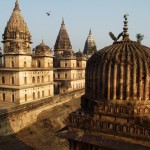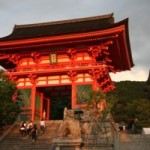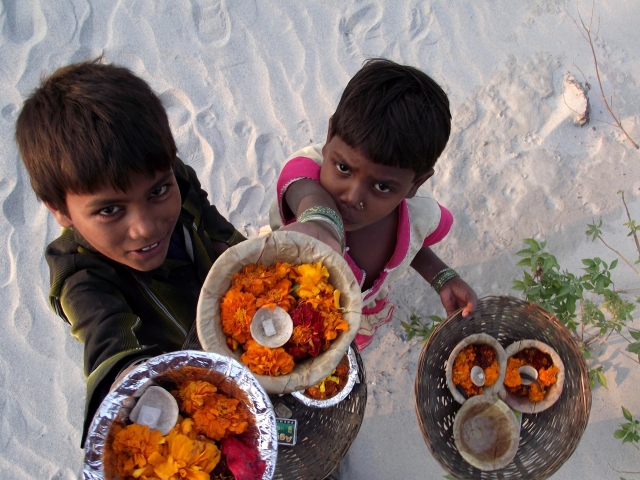
The small, spiritual village of Rishikesh (population 80,000), in northern India’s Uttarakhand state, sits at the base of the Himalayan mountain range and straddles both banks of the young Ganges River. It is a designated sacred site, the home of dozens of ashrams, a destination for millions of Indian pilgrims as well as foreign tourists, and considered by many to be the “yoga capital of the world”. It is also where the Beatles visited in 1968, meditated with the Maharishi and were inspired to write such classic songs as “Dear Prudence” and “Sexy Sadie”.
Immersion into Indian culture, another world
I decided to head for Rishikesh after flying into Delhi, India’s third-largest city, and the capital of the massive country or “Indian subcontinent” as some refer to it. A friend had made Rishikesh sound like a good place to begin the immersion process into Indian culture for my five months of traveling there; especially after reeling from the inevitable culture shock upon arriving in one of the largest, and poorest cities in the world. India can now boast that it holds more than 1.2 billion people within its borders—or approximately one-sixth of the population of the world. Unfortunately, it is also one of the most poverty-stricken countries on Earth; and this fact is plainly evident as soon as you leave the airport behind and venture into the impoverished city. After exploring the maze of Delhi for a few days, I took an early-morning express train ride northeast across the wide, flat Ganges River plain, which encompasses much of Uttar Pradesh state. It seemed that we covered a lot of terrain in the course of four hours. But upon consulting my map, I realized that it was just a little blip in the vastness of India. A good hour of that ride was spent simply getting out of Delhi. I found myself mesmerized and amazed, yet sobered and humbled by the teeming multitudes I witnessed from the train window, and the virtually endless sprawl of filthy, decrepit shanty towns, which literally millions of people inhabited. These makeshift structures seemed, simply by their numbers, threatening to engulf the small island of relative wealth and modernization at the center of the city. India was undoubtedly another world, even beyond my wildest imaginings.
Journey to Rishikesh
At the town of Haridwar (one of the four holy Indian cities which hosts the massive Kumbha Mela, a sacred Hindu spiritual gathering) the train line ended at the Himalayan foothills, and I had to transfer to a bus. I picked my way through the beggars and homeless families who lined the train station inside and out, and then walked down the frenzied main street to the nearby bus station. As it was a well-traveled route from there to Rishikesh, a bus was leaving shortly. On the short half-hour bus ride from Haridwar up into the hills, I ended up sitting next to an Israeli traveler named Noam. He had been traveling in India for a few months already, and had some helpful tips to pass on. I was happy to soak up whatever knowledge he could share, as I was still in the cultural adjustment phase, teetering on the edge between fascinated and overwhelmed. As we finally hopped off the bus in Rishikesh, Noam and I decided to look for a hotel together and see about sharing a room for a few days, to cut down on expenses.
Rishikesh a first glance
At first glance, I was actually rather disappointed with Rishikesh. It didn’t seem at all to be the simple, romanticized, spiritual village my friend had described to me. It looked more or less like every other hurried, congested, chaotic, garbage-strewn town we had passed through on the way there. After wandering around the village and investigating for a little while, Noam and I double-checked our guidebooks. There were a few hotels a little ways out of town, on the other side of the river. We decided to trek up that way and see if that part of town was any different from what we had seen so far.
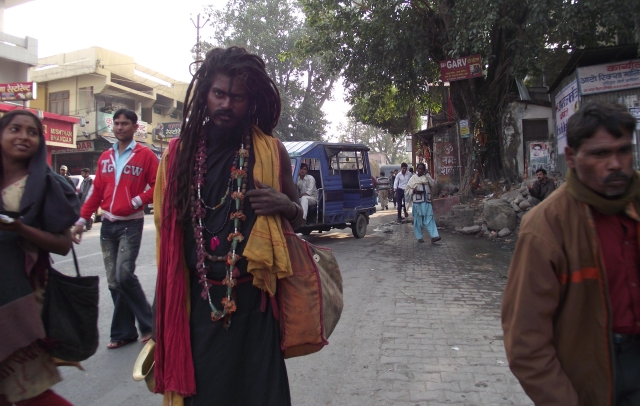
Things definitely got more interesting as we hiked up a main road that seemed to be heading out of town—and I was given my first sight of the mighty Ganges River. Although still of a respectable size, it was much smaller than the photographs I’d seen in assorted picture books. This was because its headwaters at Gangotri Glacier were less than a hundred miles away. It still had another 1,500 miles to go before emptying its contents—of water, silt, pollution, garbage, human waste, human remains and who knew what else—into Bangladesh’s Bay of Bengal. Yet, here the water seemed relatively clean and fairly calm. It flowed steadily, silently along, as scattered groups of Indian worshipers stood at its barren banks. A few of them crouched down, saying silent prayers, or else bringing the water to their mouths to drink. Some even bathed at the water’s edge; others brushed their teeth. The river was clearly a source of both spiritual inspiration, as well as practical necessity.
Finding the real Rishikesh
The busy road followed along the river for a mile or so (which we could have traveled by taxi for mere pennies rather than by foot with our backpacks, if we’d been more sure of where we were headed) before it came to a small, pleasant marketplace area. Just beyond the market was a large and magnificent suspension bridge spanning the Ganges, known as the Ram Jhula. On the other side of the bridge, we could see the many ashrams and stone ghats (designated bathing areas along the river) that had been described with such appeal by my guidebook. Noam and I wandered casually through the marketplace. Then we crossed over the narrow bridge, traversable only by foot or motorcycle, to the other side of the river. Here was the quiet, slow-paced, spiritual Rishikesh we both had been anticipating. Upon stepping off the bridge, we immediately felt our spirits rise, and our bodies relax.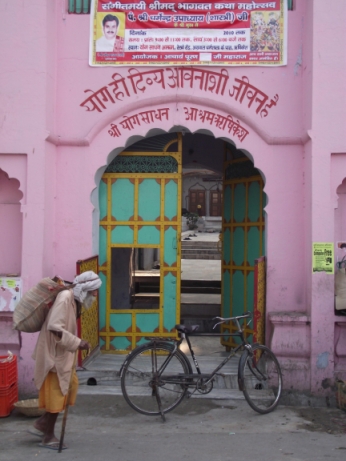 After wandering around for a bit through the narrow, cobbled streets devoid of automobiles (neither of the two nearby bridges allowed cars), Noam and I settled on the Green Hotel. After checking in and claiming a room, we left our backpacks on the beds, put a lock on the door, and then went out to find a good thali at a local restaurant (basic Indian meal including vegetable dishes, rice and chapati bread). Later we stopped for a chai (black tea with lots of milk and sugar) at a small chai stand; and then went down to one of the ghats along the Ganges to watch the setting sun. Noam and I roomed together for the next week. And I ended up staying in Rishikesh for another two weeks after that. We easily filled the days with meals, chai, yoga, watching the river flow and the Indian pilgrims worshiping at its banks, as well as hanging out with fellow Western travelers. On our second evening there, at dinner again, we struck up a conversation with a young female solo traveler at the next table named Melody. She was from London, although of Persian origin. Since she was alone, we invited her to our table. After dinner and conversation, we all decided to meet up the next day for a walk up the road along the Ganges, to see what else of interest was in the area.
After wandering around for a bit through the narrow, cobbled streets devoid of automobiles (neither of the two nearby bridges allowed cars), Noam and I settled on the Green Hotel. After checking in and claiming a room, we left our backpacks on the beds, put a lock on the door, and then went out to find a good thali at a local restaurant (basic Indian meal including vegetable dishes, rice and chapati bread). Later we stopped for a chai (black tea with lots of milk and sugar) at a small chai stand; and then went down to one of the ghats along the Ganges to watch the setting sun. Noam and I roomed together for the next week. And I ended up staying in Rishikesh for another two weeks after that. We easily filled the days with meals, chai, yoga, watching the river flow and the Indian pilgrims worshiping at its banks, as well as hanging out with fellow Western travelers. On our second evening there, at dinner again, we struck up a conversation with a young female solo traveler at the next table named Melody. She was from London, although of Persian origin. Since she was alone, we invited her to our table. After dinner and conversation, we all decided to meet up the next day for a walk up the road along the Ganges, to see what else of interest was in the area.
Our daily ritual on the Ganges River
The following day the three of us wandered north past the Ram Jhula bridge, towards what our guidebook identified as the Lakshman Jhula bridge. Eventually, we came to another marketplace area surrounding the impressive 13-story Kailashanand Mission Temple, right near the Lakshman Jhula suspension footbridge. We stopped to buy some fruit and snacks for lunch at the market, and then continued walking up the road. It meandered out of the crowded market, continuing along the Ganges. Soon we came to a wide, sandy beach area along the river, and decided to stop there to rest for a while and have lunch. We walked down to the beach and planted ourselves in the sand. After eating and watching the cool water flow endlessly by, we all decided to go for a cautious swim in the shallow water at the edge of the Ganges. A week or so later, after Noam and Melody had both traveled on, I walked back up to the same area to go for another swim; as this had become an almost daily ritual. However, this time I was greeted with an unexpected situation—a cremation ceremony was in progress on the beach. At first, I was a little alarmed and thought perhaps I should leave right away out of respect. But I noticed another person sitting nearby, whom the family didn’t seem to mind. So, I decided also to stay and watch them from a distance for a little while. I had heard that in India it was considered a great blessing for the dead to be sent down the Ganges River. But witnessing such a ritual in progress was a uniquely humbling experience that I couldn’t help but appreciate, given the opportunity.
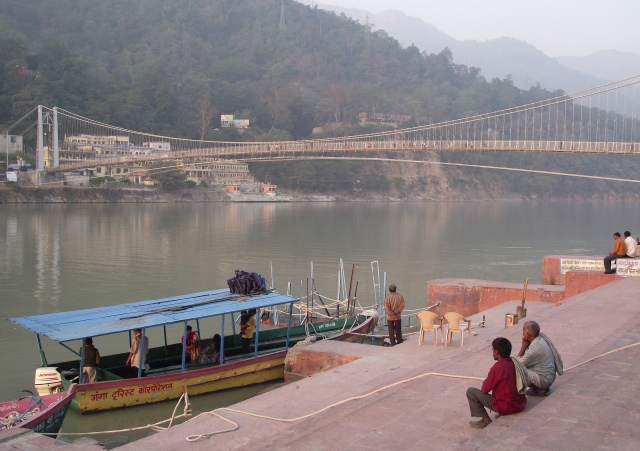
I noticed that those conducting the ceremony seemed relatively casual in their manner, given the serious nature of the event. Although clearly somber, they talked, smiled and even laughed quietly on occasion, as they piled wood around the casket. Then they gathered together for a few prayers, as one of the men poured fuel over the arrangement. He threw a match on it, and it went up in flames. Their mood turned more solemn as they watched the flaming pyre. I stayed a bit longer; until it became clear that it would be a while before it all burned down to ashes. At that point, whatever remained would then be sent down the river. I decided to leave them in peace for the rest of the ceremony—and besides, I’d seen enough for the time being. I walked back up to the road; and then made my way slowly back towards town, along the way contemplating the depth and richness of this very foreign culture.



